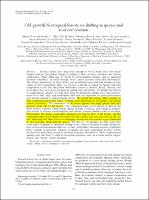Old-growth neotropical forests are shifting in species and trait composition
Fecha de publicación
2016Autor
Van der Sande, Masha T.
Arets, Eric J.M.M.
Peña Claros, Marielos
Avila, Angela Luciana de
Roopsind, Anand
Mazzei, Lucas
Ascarrunz, Nataly
Finegan, Bryan
Alarcón, Alfredo
Cáceres Siani, Yasmani
Licona, Juan Carlos
Ruschel, Ademir
Toledo, Marisol
Poorter, Lourens
Tipo
Artículo
Metadatos
Mostrar el registro completo del ítemResumen
Tropical forests have long been thought to be in stable state, but recent insights indicate that global change is leading to shifts in forest dynamics and species composition. These shifts may be driven by environmental changes such as increased resource availability, increased drought stress, and/or recovery from past disturbances. The relative importance of these drivers can be inferred from analyzing changes in trait
values of tree communities. Here, we evaluate a decade of change in species and trait composition across five old-growth
Neotropical forests in Bolivia, Brazil, Guyana, and Costa Rica that cover large gradients in rainfall and soil fertility. To identify the drivers of compositional change, we used data from 29 permanent sample plots and measurements of 15 leaf, stem, and whole-plant traits that are important for plant performance
and should respond to global change drivers. We found that forests differ strongly in their community-mean trait values, resulting from differences in soil fertility and annual rainfall seasonality. The abundance of deciduous species with high specific leaf area increases from wet to dry forests. The community-mean wood density is high in the driest forests to protect xylem vessels against drought cavitation, and is high in nutrient-poor forests to increase wood longevity and enhance nutrient residence time in the plant. Interestingly, the species composition changed over time in three of the forests, and the
community-mean wood density increased and the specific leaf area decreased in all forests, indicating that these forests are changing toward later successional stages dominated by slow-growing, shade-tolerant species. We did not see changes in other traits that could reflect responses to increased drought stress, such as increased drought deciduousness or decreased maximum adult size, or that could reflect increased resource availability (CO2, rainfall, or nitrogen). Changes in species and trait composition in these forests are therefore most likely caused by recovery from past disturbances. These compositional changes may also lead to shifts in ecosystem processes, such as a lower carbon sequestration and “slower” forest dynamics.
Palabras clave
Status
restrictedAccess
URI (Enlace permanente para citar o compartir este ítem)
https://repositorio.catie.ac.cr/handle/11554/8486https://doi.org/10.1890/15-1815.1


